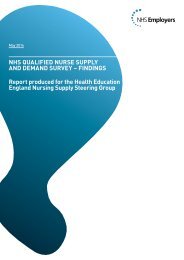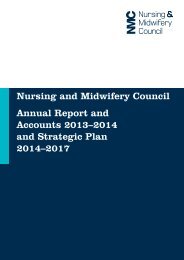Journal_1_2014_final_WEB
Journal_1_2014_final_WEB
Journal_1_2014_final_WEB
You also want an ePaper? Increase the reach of your titles
YUMPU automatically turns print PDFs into web optimized ePapers that Google loves.
During period of stress or trauma such as injury and<br />
wound healing, certain amino acids, such as arginine and<br />
glutamine, become conditionally essential.<br />
L-Arginine is composed of 32% nitrogen and has been<br />
shown to increase the concentration of hydroxyproline,<br />
an indicator of collagen deposition and protein, at the<br />
wound site. 3,4 Faster wound healing has been described<br />
in non-malnourished patients with stage III-IV PUs who<br />
received an oral nutritional supplement (ONS) containing<br />
arginine, protein, zinc, ascorbic acid, and vitamin E. 5<br />
Water<br />
Water is distributed throughout the body in intracellular,<br />
interstitial, and intravascular compartments and serves as<br />
the transport medium for moving nutrients to the cells and<br />
removing waste products. Fluids are solvents for minerals,<br />
vitamins, amino acids, glucose, and other small molecules,<br />
thus enabling them to diffuse into and out of cells. Individuals<br />
with draining wounds, diarrhoea, elevated temperature,<br />
or increased perspiration require additional fluids to<br />
replace the fluid lost. 6 Water constitutes 60% of an adult’s<br />
body. The elderly individual generally has an increase in<br />
body fat and a decrease in lean body mass, resulting in a<br />
decrease in the percentage of water stored. This decrease<br />
in body water, coupled with a diminished sense of thirst,<br />
places the elderly at particular risk for dehydration. 7 Hydration<br />
needs are met from liquids plus the water content<br />
of food, which accounts for 19% to 27% of the total fluid<br />
intake of healthy adults. 8<br />
Vitamins and Minerals<br />
The role of micronutrients in promoting wound healing<br />
is debatable. 1<br />
Ascorbic acid (vitamin C), a water-soluble vitamin,<br />
is a cofactor with iron during the hydroxylation of proline<br />
and lysine in the production of collagen. Therefore,<br />
a deficiency of vitamin C may prolong the healing time<br />
and contribute to decreased resistance to infection. 9 The<br />
required daily intake of vitamin C is achieved through<br />
the consumption of fruits and vegetables. Mega doses of<br />
ascorbic acid have not resulted in accelerated pressure ulcer<br />
healing. 10<br />
Vitamin A and Vitamin E are fat-soluble vitamins and<br />
dietary intake of these vitamins comes from a variety of<br />
foods. Vitamin A acts as a stimulant during the wound<br />
healing process to increase collagen formation and promote<br />
epithelisation. High doses of Vitamin A are not<br />
recommended without consultation with a physician.<br />
Vitamin E acts as an anti-oxidant and the required intake<br />
can easily be met with food and/or a multivitamin unless<br />
a deficiency is confirmed.<br />
Zinc, a cofactor for collagen formation, also enhances<br />
metabolism of protein, liberates vitamin A from storage<br />
in the liver, and assists in immune function. Unless a deficiency<br />
is confirmed, elemental zinc supplementation is<br />
not recommended for individuals with wounds such as<br />
pressure ulcers. 11,12 Copper is a mineral that is essential<br />
for collagen cross-linking. Zinc and copper compete for<br />
the same biding site on the albumin molecule, thus high<br />
serum zinc levels interfere with copper metabolism and can<br />
induce copper deficiency. 13,14 If deficiencies are suspected,<br />
a multivitamin with minerals may be appropriate.<br />
The nutritional cycle<br />
Screening and assessment of nutritional status followed<br />
by adequate nutritional intervention should be part of<br />
the prevention and treatment plan for patients at risk for<br />
(chronic) wounds. 1<br />
Pressure ulcers are a representative example of such<br />
wounds.<br />
The ‘why’ of this statement is clearly revealed by the<br />
literature related to PUs, which are used as an example<br />
here. The essentials, however, also apply to other types<br />
of wound such as chronic venous leg ulcers, arterial leg<br />
ulcers, and diabetic foot ulcers, in which nutritional care<br />
is additional to other disease-specific interventions.<br />
Nutritional status and PUs<br />
Whether a patient develops a PU depends on both extrinsic<br />
and intrinsic factors. Important extrinsic factors<br />
(coming from outside the patient) are pressure, friction,<br />
and shear forces. 15<br />
Intrinsic (patient-related) factors affect tissue viability<br />
and therefore the tissue response to mechanical loading.<br />
A number of intrinsic factors have been described in<br />
the literature. An adequate nutritional status is one of the<br />
most important intrinsic factors, and also one that can be<br />
readily influenced. 16,17<br />
Poor nutritional intake and poor nutritional status have<br />
both been identified as key risk factors for pressure ulcer<br />
development and protracted wound healing. Notwithstanding<br />
methodological shortcomings, cross-sectional<br />
and prospective studies suggest a fairly strong correlation<br />
between undernutrition and pressure ulcer development.<br />
18-21 Moreover, it appears that many acutely or<br />
chronically ill patients and elderly patients who are at risk<br />
of pressure ulcer development or have established pressure<br />
ulcers suffer from undesired weight loss. 22-26<br />
32<br />
EWMA <strong>Journal</strong> <strong>2014</strong> vol 14 no 1




